National Association for the Practice of Anthropology
NAPA Has Standards! Webinar
Introduction to NAPA’s Professional Standards
Self Awareness Standard
Cultural Relativism Standard
Engagement and Service Standard
Empowerment and Advocacy Standard
Transparency and Accuracy Standard
Accessibility Standard
Command of Our Craft Standard
Reflections and Going Forward
Why Professional Standards?
- Professional, practicing, and applied anthropologists (PPA) are the rising majority of the anthropological work continuum in the United States; that disciplinary dominance will only continue in the future.
- Few schools are prepared to fully train anthropologists for the kinds of work that PPA anthropologists undertake.
- No one has prepared grounded guidance for what good and ethical PPA anthropologists will do in their work.
- The Disciplinary Standards are important as guidance for PPA anthropologists.
- The Disciplinary Standards are also necessary to ground all training materials to be developed.
For feedback or suggestions, please use this form: https://syracuseuniversity.qualtrics.com/jfe/form/SV_86dRvDa6TJuBGEC

NAPA HAS STANDARDS!
New Guidance for Professional, Practicing, and Applied Anthropologists
[NAPA Logo]
A WEBINAR TO CELEBRATE THE 40TH ANNIVERSARY OF NAPA
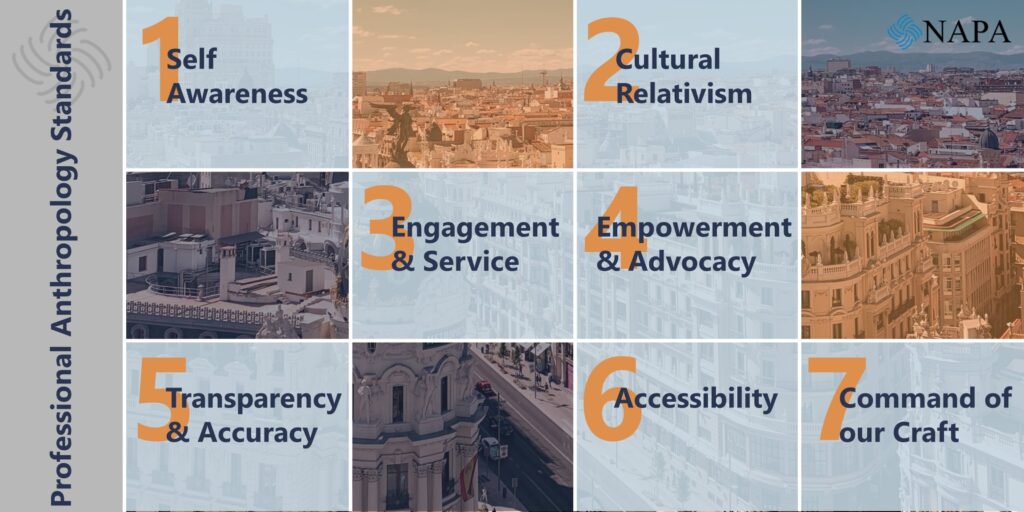
Core Concepts
- Self Awareness
- Cultural Relativism
- Engagement & Service
- Empowerment & Advocacy
- Transparency & Accuracy
- Accessibility
- Command of our Craft
Each Core Concept is divided into Basic Elements that includes examples of Observable Indicators. The Observable Indicators are not meant to be an exhaustive list, but serve as a springboard for deeper discussion.

The Core Concept of Self Awareness is broken up into four Basic Elements which include several examples of Observable Indicators. .
- Seek feedback from peers, clients, and partners
- Measure against disciplinary, industry, and community standards
- Practice reflexivity
- Recognize personal and professional limits
- Admit what you don’t know or can’t do
- Ask for and receive advice openly
- Stay open to continual improvement and professional development
- Be aware of and address overconfidence
- Seek feedback from others
- Identify areas for development and improvement
- Learn from other professionals and emulate successful professional behavior
- Consider how clothing, hair, makeup, and jewelry choices impact perception in different contexts
- Understand professionalism and its components
- Demonstrate and apply professional skills in work situations
- Prioritize purpose over personal interests
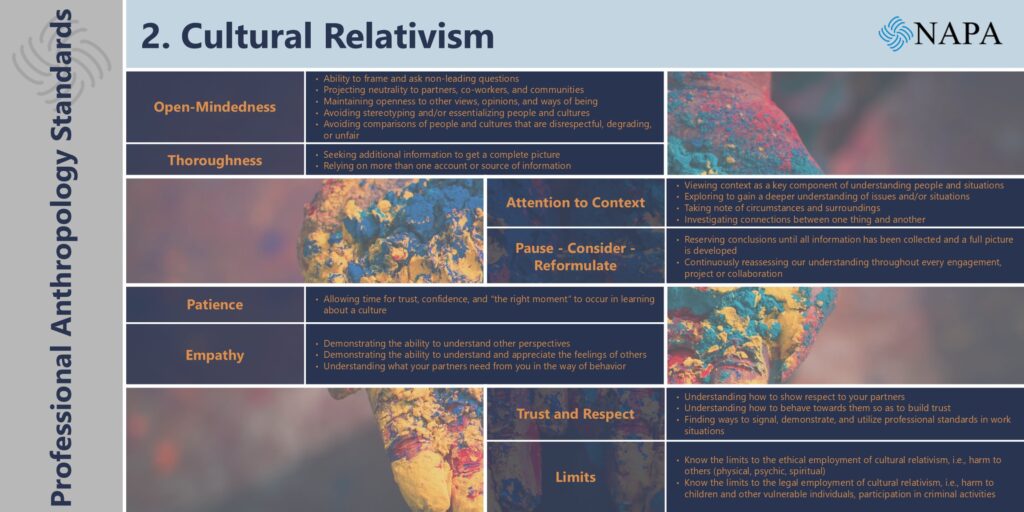
The Core Concept of Cultural Relativism is broken up into eight Basic Elements which include several examples of Observable Indicators for each.
- Framing and asking non-leading questions
- Projecting neutrality with partners and communities
- Maintaining openness to diverse perspectives and ways of being
- Avoiding stereotyping or essentializing cultures
- Avoiding comparisons that are disrespectful or degrading
- Seeking additional sources for a complete picture
- Relying on multiple accounts rather than a single source
- Considering context as central to understanding people and situations
- Exploring deeper layers of issues and circumstances
- Noting surroundings and investigating connections
- Reserving conclusions until all information is gathered
- Reassessing understanding throughout engagement
- Allowing time for trust and confidence to develop
- Demonstrating understanding of perspectives and emotions
- Recognizing partners’ behavioral expectations
- Knowing how to signal professionalism and build trust
- Understanding respectful behavior toward collaborators
- Recognizing ethical boundaries, including harm prevention
- Understanding legal restrictions concerning vulnerable groups and criminal participation
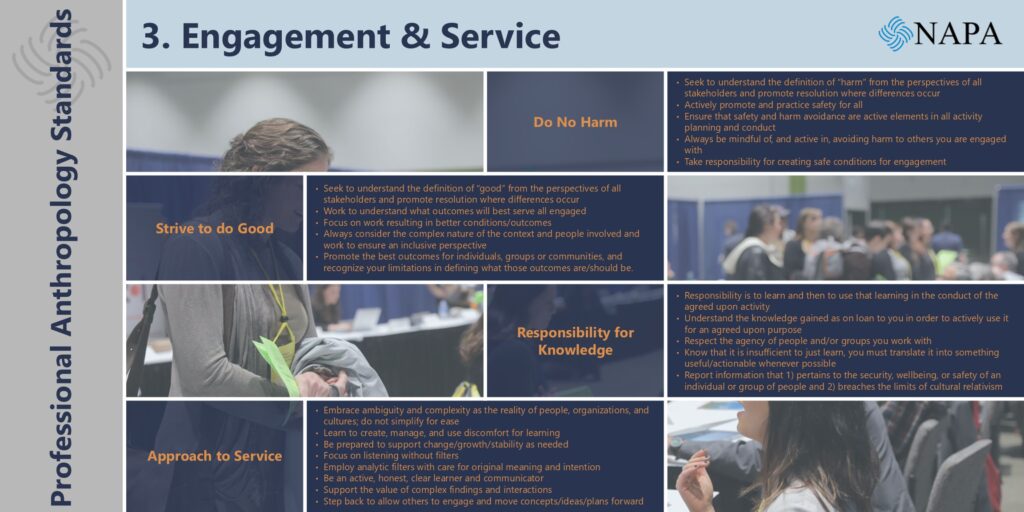
The Core Concept of Engagement and Service is broken up into four Basic Elements. Each includes several examples of Observable Indicators.
- Understanding “harm” from multiple stakeholder perspectives
- Actively promoting safety and incorporating harm avoidance in all planning
- Taking responsibility for creating safe engagement conditions
- Understanding “good” from various perspectives and resolving differences
- Working toward positive outcomes while considering complexity
- Supporting inclusive perspectives and recognizing personal limitations in defining outcome
- Learning actively and applying knowledge responsibly
- Treating knowledge as entrusted and using it for agreed purposes
- Respecting the agency of collaborators
- Reporting information that impacts security and safety
- Embracing ambiguity and complexity rather than oversimplifying
- Using discomfort as a learning tool
- Supporting change and growth while listening attentively
- Communicating with flexibility, honesty, and clarity
- Remaining mindful of diverse realities and informed intentions
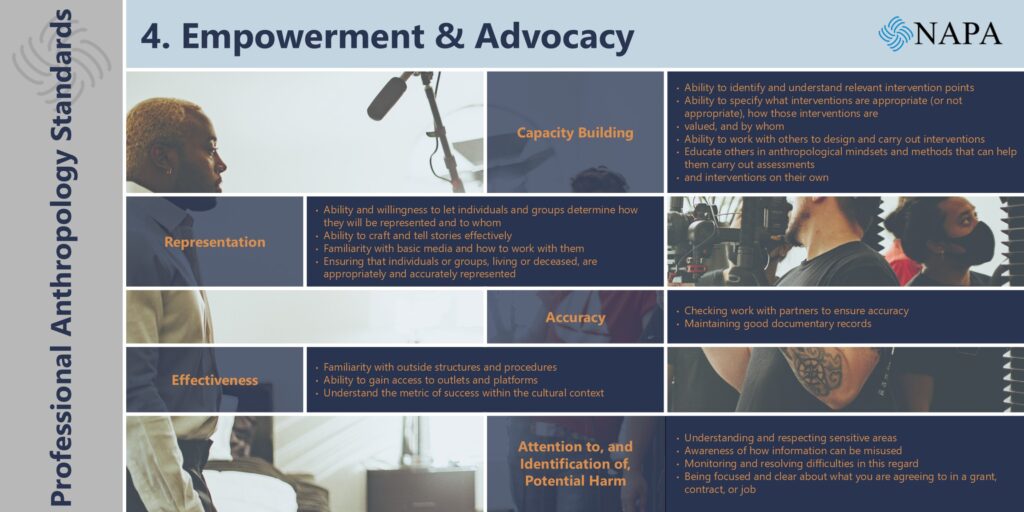
The Core Concept of Empowerment and Advocacy is broken up into five Basic Elements, each of which includes several examples of Observable Indicators.
- Identifying and understanding relevant intervention points
- Determining appropriate interventions and assessing their value
- Collaborating with others to design and implement interventions
- Educating others in anthropological methods to enable self-sustained assessments
- Allowing individuals and groups to define their own representation
- Crafting and communicating stories effectively
- Working with media appropriately
- Ensuring accurate representation of living and deceased individuals
- Verifying work with partners to ensure correctness
- Keeping thorough documentary records
- Understanding external structures and procedures
- Securing access to relevant outlets and platforms
- Evaluating success within cultural contexts
- Recognizing and respecting sensitive areas
- Being aware of how information can be misused
- Monitoring and addressing potential ethical difficulties
- Clarifying agreements in contracts, grants, and job expectations
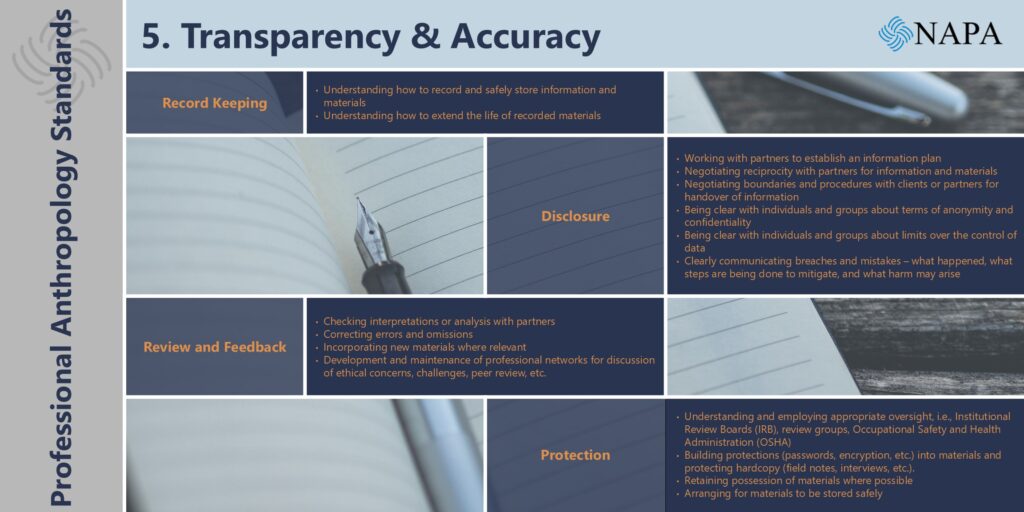
The Core Concept of Transparency and Accuracy is broken up into four Basic Elements which include several examples of Observable Indicators for each.
- Understanding how to record and safely store information and materials
- Extending the life of recorded materials
- Establishing an information plan with partners
- Negotiating reciprocity with partners for information and materials
- Setting boundaries and procedures with clients or partners for handover of information
- Clearly defining anonymity and confidentiality terms
- Communicating limits over the control of data
- Reporting breaches or mistakes transparently, including mitigation steps
- Checking interpretations or analysis with partners
- Correcting errors and omissions
- Incorporating relevant new materials
- Maintaining professional networks for ethical discussion and peer review
- Employing appropriate oversight (IRB, review groups, OSHA)
- Securing materials with encryption and passwords
- Protecting hardcopy field notes, interviews, and other sensitive materials
- Arranging for secure storage of materials
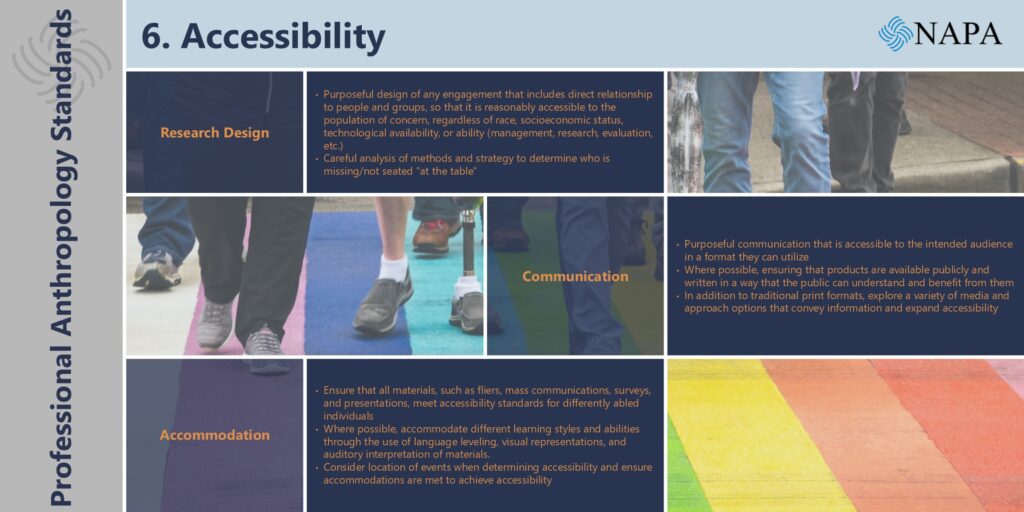
The Core Concept of Accessibility is broken up into three Basic Elements, each of which include several examples of Observable Indicators.
- Ensuring accessibility regardless of race, socioeconomic status, technological availability, or ability
- Analyzing methods and strategies to identify missing or excluded groups
- Making communication accessible in formats suited to the intended audience
- Providing publicly available products with language that benefits a broad audience
- Exploring different media and approaches to expand accessibility
- Ensuring materials like fliers, surveys, and presentations meet accessibility standards
- Accommodating different learning styles through language, visuals, and auditory interpretation
- Considering event locations and meeting accessibility needs
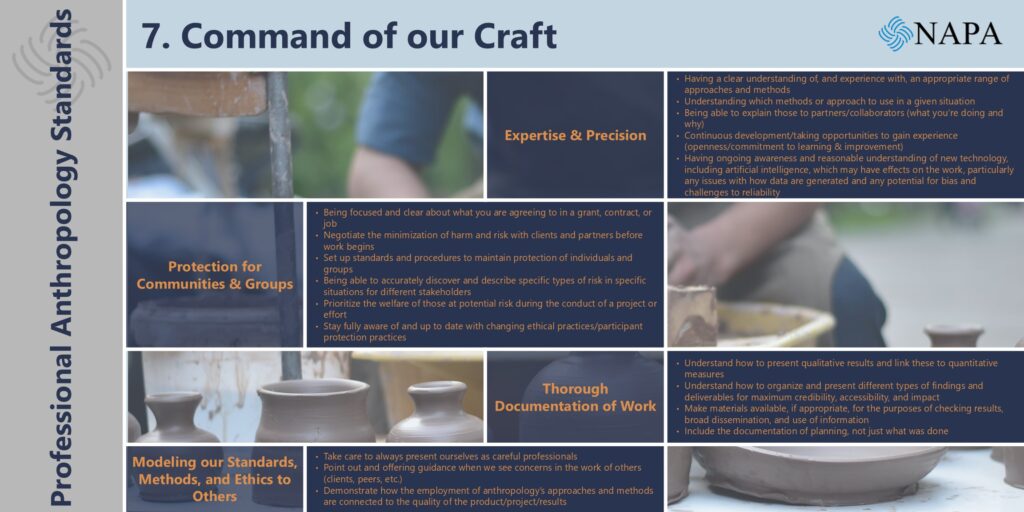
The Core Concept of Command of Our Craft is broken up into four Basic Elements. Each includes several examples of Observable Indicators.
- Knowing the right methods for specific situations and explaining them to collaborators
- Commitment to continuous learning and improvement
- Staying informed about new technology, including artificial intelligence, and its potential effects on work
- Defining responsibilities in grants, contracts, or jobs
- Negotiating harm minimization with clients and partners before work begins
- Establishing standards and procedures for protection
- Identifying and addressing risks for different stakeholders
- Prioritizing the welfare of potentially at-risk individuals throughout projects
- Staying up to date with evolving ethical and participant protection practices
- Linking qualitative and quantitative results effectively
- Organizing findings and deliverables for credibility and impact
- Making materials available when appropriate for verification and broad dissemination
- Documenting planning, not just actions taken
- Maintaining a professional presence
- Offering guidance when noticing concerns in others’ work
- Ensuring the quality of projects and results
Joshua Liggett, MS, LSSBB, CPHQ
Joshua has a passion for working with people to solve human problems and striving to make the world a more benevolent and efficient place to call home. Trained as a professional anthropologist, his expertise includes design and execution of both qualitative and quantitative data collection, management, analysis, and reporting for the purposes of evaluation and identifying improvement opportunities.

![[NAPA Logo] sNAPAshots: Conversations with Professional, Practicing, and Applied Anthropologists. Rosalie Post, Design Anthropologist, Co-founder of NAMLA. PracticingAnthropology.org Bluesky, X, Meta, LinkedIn, and Youtube Logos](https://practicinganthropology.org/wp-content/uploads/Rosalie-Post-LinkedIn-Flyer-768x768.jpg)

![[NAPA Logo] sNAPAshots: Conversations with Professional, Practicing, and Applied Anthropologists. Steven Thomson, Organizational Anthropologist, Summit Pacific Medical Center. PracticingAnthropology.org Bluesky, X, Meta, LinkedIn, and Youtube Logos](https://practicinganthropology.org/wp-content/uploads/Steven-Thomson-e1756780727721-768x769.png)
[…] NAPA Has Standards! Webinar […]
One smalll editorial sugggestion:
In No. 5, Transparency & Accuracy, rearrange the “elements” — Put Disclosure and Review/feedback first, because they both relate to Transparency. Then Record-keeping and Protection after them, as they relate more to accuracy.
I suggest a few small changes to the standards presented at SfAA on 29 March:
1. Add clothing/jewelry choices as an indicator to the element of Prewssentation of Professional Self in Self-awareness Concept.
2. In Concept No. 4 – I suggest splitting the Element of Capacity building into two: One should be Needs assessment, sspecification of appropriate interventions. The other could be Capacity building, which is a standard term in development work meaning building up people’s ability to help themselves.
I echo the suggestion of adding a preamble about the kinds of work situations in which these standards may be of use. I suggest that you also explain what “anthropology” is (four fields in U.S., different definitions elsewhere), because it isn’t always clear to professionals in other disciplines what we may do, what different specialties are. And in different countries anthropology has different meanings.
Explain PPA too, of course.
There are a few organizations beyond AAA, SfAA that might be interested in this effort. One is the International Sociological Association, which has an applied wing that they call “”clinical.” . I can give contact information later.
Congratulations on your amazing effort and smart process!